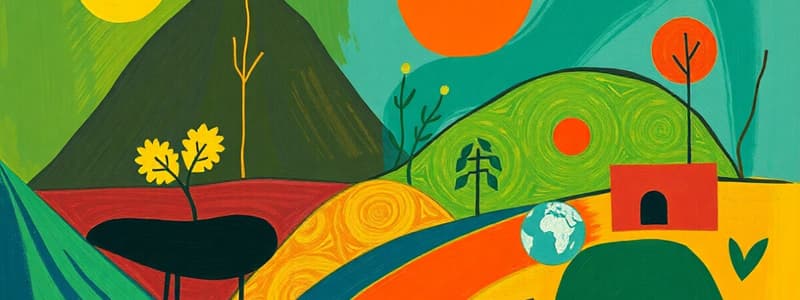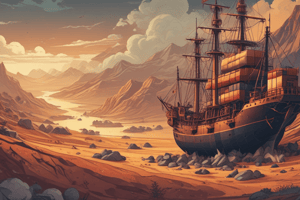Podcast
Questions and Answers
What are the two main classifications of natural resources?
What are the two main classifications of natural resources?
- Organic and Inorganic
- Exhaustible and Renewable
- Biotic and Abiotic
- Non-metallic and Metallic (correct)
Which of the following best describes physical capital?
Which of the following best describes physical capital?
- The skills of the workforce
- The contractors who build factories
- The buildings and tools used for production (correct)
- The profit made from selling goods
How does human capital contribute to production?
How does human capital contribute to production?
- By providing physical resources
- Through financial investments
- By managing supply chains
- By operating machinery and providing services (correct)
What is the primary reason why physical capital is considered useless without human capital?
What is the primary reason why physical capital is considered useless without human capital?
Scarcity arises because of which of the following reasons?
Scarcity arises because of which of the following reasons?
In the context of scarcity, how does time limitation affect individual choices?
In the context of scarcity, how does time limitation affect individual choices?
Which is NOT a component of physical capital?
Which is NOT a component of physical capital?
How do capital resources primarily serve society?
How do capital resources primarily serve society?
What is the primary reason scarcity necessitates making choices?
What is the primary reason scarcity necessitates making choices?
Which of the following best describes opportunity cost?
Which of the following best describes opportunity cost?
How does the production-possibility frontier (PPF) illustrate economic concepts?
How does the production-possibility frontier (PPF) illustrate economic concepts?
If a student chooses to study for an exam instead of attending a concert, what represents the opportunity cost?
If a student chooses to study for an exam instead of attending a concert, what represents the opportunity cost?
What does the term 'factors of production' refer to in the context of the PPF?
What does the term 'factors of production' refer to in the context of the PPF?
Which of the following scenarios best illustrates the concept of scarcity?
Which of the following scenarios best illustrates the concept of scarcity?
What does a point inside the production-possibility frontier indicate?
What does a point inside the production-possibility frontier indicate?
When an economy produces a combination of goods at a point on its production-possibility frontier, this indicates what?
When an economy produces a combination of goods at a point on its production-possibility frontier, this indicates what?
What does point A on the production-possibility frontier represent?
What does point A on the production-possibility frontier represent?
Which point on the PPF indicates an inefficient use of resources?
Which point on the PPF indicates an inefficient use of resources?
What can be inferred if the country produces at point C on the PPF?
What can be inferred if the country produces at point C on the PPF?
How many copies of books can be produced if the country produces 12.5 million loaves of bread?
How many copies of books can be produced if the country produces 12.5 million loaves of bread?
Which of the following combinations represents a trade-off on the PPF?
Which of the following combinations represents a trade-off on the PPF?
Which of these points shows a combination of goods produced that is not achievable given current resources?
Which of these points shows a combination of goods produced that is not achievable given current resources?
What is the main objective of the production-possibility frontier?
What is the main objective of the production-possibility frontier?
What condition is necessary for an economy to reach point G on the PPF?
What condition is necessary for an economy to reach point G on the PPF?
What is the maximum number of loaves of bread that can be produced when no books are produced?
What is the maximum number of loaves of bread that can be produced when no books are produced?
What does a movement along the PPF indicate?
What does a movement along the PPF indicate?
What opportunity cost occurs when moving from point B to point C?
What opportunity cost occurs when moving from point B to point C?
Which of the following best describes a rightward shift in the PPF?
Which of the following best describes a rightward shift in the PPF?
If Country X moves from Point A to Point B on the PPF, what is the total reduction in bread production?
If Country X moves from Point A to Point B on the PPF, what is the total reduction in bread production?
Which point represents an unattainable combination of goods on the PPF?
Which point represents an unattainable combination of goods on the PPF?
What can cause a leftward shift in the PPF?
What can cause a leftward shift in the PPF?
What term describes the benefits gained from producing more of one good and sacrificing the production of another?
What term describes the benefits gained from producing more of one good and sacrificing the production of another?
What does the term 'rent' refer to in the context of business payments?
What does the term 'rent' refer to in the context of business payments?
Which of the following describes 'marginal cost'?
Which of the following describes 'marginal cost'?
Which of the following represents a fixed input in production?
Which of the following represents a fixed input in production?
When observing the Law of Diminishing Marginal Returns, what typically occurs after a certain number of workers are added?
When observing the Law of Diminishing Marginal Returns, what typically occurs after a certain number of workers are added?
What is the formula for calculating total cost (TC)?
What is the formula for calculating total cost (TC)?
What role does 'entrepreneurship' play in business according to the factors of production?
What role does 'entrepreneurship' play in business according to the factors of production?
Which of the following is an example of a variable cost?
Which of the following is an example of a variable cost?
What occurs when the average variable cost (AVC) and average fixed cost (AFC) are added together?
What occurs when the average variable cost (AVC) and average fixed cost (AFC) are added together?
In a sole proprietorship, how many owners are involved?
In a sole proprietorship, how many owners are involved?
Flashcards are hidden until you start studying
Study Notes
Natural Resources
- Classified into non-metallic (e.g., oil, molave tree) and metallic (e.g., copper, iron, gold).
Capital Resources (CR)
- Comprise physical capital and human capital, crucial for producing goods and services.
Physical Capital
- Includes structures, equipment, and inventory.
- Structures: Buildings for factories, offices, malls, etc., where production occurs.
- Equipment: Tools and machinery (e.g., tractors, ovens) that aid in production.
- Inventory: Raw materials and finished goods available for sale.
Human Capital
- Refers to employed individuals with specific skills who operate machinery and provide services.
- Essential for utilizing physical capital effectively; without workers, physical capital cannot produce goods.
Scarcity and Choice
- Scarcity: Limited resources prevent satisfying all human wants.
- Affects individuals and society, leading to prioritization of desires.
Choice
- Scarcity forces choices about which wants to satisfy and which to forgo.
- Choices involve trade-offs between available alternatives.
Opportunity Cost
- The cost of making a choice is the value of the next best alternative given up.
- Example: Choosing to review for an exam means sacrificing the opportunity to watch a concert.
Product-Possibility Frontier (PPF)
- A graphical representation showing combinations of goods an economy can produce with available resources and technology.
- Demonstrates concepts of scarcity, efficiency, choice, and opportunity cost.
PPF Combinations
- Various points on the PPF illustrate different production levels, such as books and bread for Country X.
- Points along the PPF indicate efficient use of resources.
- Points inside the PPF signify inefficiency, while points outside are unattainable without more resources or better technology.
PPF and Efficiency
- Points on the PPF showcase maximum production capabilities.
- Inefficient points within the PPF do not fully utilize resources, leading to waste.
PPF and Scarcity
- Represents the limits of production given scarce resources, with unattainable points requiring improved factors or technology to reach.
PPF and Choice + Opportunity Cost
- Movement between points on the PPF indicates trade-offs, with opportunity costs defined by the quantity of goods forgone when producing more of another.
Shift in the PPF
- A rightward shift in the PPF indicates improvements, such as increased resources or technological advancements resulting in higher production.
Factors of Production
- Land: Natural resources used in production.
- Labor: Workforce employed in various tasks.
- Capital: Physical or financial assets used in production.
- Entrepreneurship: Individuals who innovate and operate businesses.
Payments for Factors of Production
- Rent: Compensation for land use.
- Wages: Payments for worker services.
- Interest: Receipts for capital services.
- Profit: Earnings after accounting for business expenses.
Types of Inputs
- Fixed Inputs: Do not change with output levels (e.g., rent).
- Variable Inputs: Change in direct relation to output levels (e.g., materials).
Law of Diminishing Marginal Returns
- Observes that as more workers are hired, the additional output (marginal product) may initially increase, but will eventually decline.
Cost Concepts
- Fixed Cost: Constant costs such as rent and salaries.
- Variable Cost: Fluctuates based on production levels (e.g., raw materials).
- Total Cost: Sum of fixed and variable costs.
- Marginal Cost: Cost of producing one more unit of output.
Cost Formulas
- Total Cost (TC) = Total Fixed Cost (TFC) + Total Variable Cost (TVC)
- Average Variable Cost (AVC) = Variable Cost / Quantity
- Average Fixed Cost (AFC) = Fixed Cost / Quantity
- Average Total Cost (ATC) = Total Cost / Quantity
- Marginal Cost (MC) = Change in Cost / Change in Quantity
Key Cost Table Example
- Displays fixed, variable, total costs, marginal costs, and average costs for various production levels, illustrating cost relationships and patterns in inputs versus outputs.
Studying That Suits You
Use AI to generate personalized quizzes and flashcards to suit your learning preferences.




